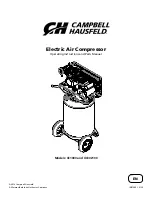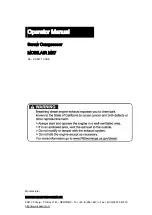
15
service centre if necessary.
13. ELECTRIC EXTENSION CORDS FOR OUTDOOR USE
When the compressor is used outdoors, only ever use
extension cords designed and marked for outdoor use.
14. STAY ALERT
Pay attention to what you are doing. Use common sense.
Do not use the compressor when you are tired. Never
use the compressor if you are under the influence of
alcohol, drugs or medicines that may cause drowsiness.
15. CHECK FOR FAULTY PARTS OR AIR LEAKS
Before using the compressor again, if a guard or any oth-
er parts are damaged, they must be carefully checked to
determine whether they can operate safely as intend-
ed. Check alignment of moving parts, pipes, pressure
gauges, pressure reducers, pneumatic connections and
any other parts that may affect normal operation. Any
damaged parts must be properly repaired or replaced by
an authorised service facility or replaced as indicated in
this instruction manual. DO NOT USE THE COMPRESSOR
IF THE PRESSURE SWITCH IS DEFECTIVE.
16. ONLY USE THE COMPRESSOR FOR THE SPECIFIED
APPLICATIONS
The compressor is a machine that produces compressed
air. Never use the compressor for any use other than
those specified in the instruction manual.
17. USE THE COMPRESSOR CORRECTLY
Operate the compressor according to the instructions in
this manual. Do not let children or anyone not familiar
with its operation use the compressor.
18. CHECK THAT ALL SCREWS, BOLTS AND COVERS ARE
SECURELY FASTENED.
Make sure that all screws, bolts and plates are securely
fastened. Check periodically that they are tight.
19. KEEP THE AIR VENT CLEAN
Keep the motor ventilation grille clean. Clean this grid
periodically if the working environment is very dirty.
20. OPERATE THE COMPRESSOR AT THE RATED VOLTAGE
Operate the compressor at the voltage specified on the
electrical data plate. If using the compressor at a higher
voltage than the rated voltage, it will result in abnormal-
ly fast motor revolution and may damage the unit and
burn out the motor.
21. NEVER USE THE COMPRESSOR IF IT IS DEFECTIVE
If the compressor makes strange noises or excessive
vibrations while it is running, or otherwise appears de-
fective, stop using it immediately and check its function-
ality or contact the nearest authorised service centre.
22. DO NOT CLEAN PLASTIC PARTS WITH SOLVENTS
Solvents such as benzene, thinner, diesel fuel or other
substances that
contain alcohol can damage plastic parts. Do not wipe
plastic parts with solvents. If necessary, clean these parts
with a soft cloth and soapy water or appropriate liquids.
23. USE ONLY GENUINE REPLACEMENT PARTS
The use of non-original spare parts will void the warran-
ty and cause the compressor to malfunction. Genuine
spare parts are available from authorised distributors.
24. DO NOT MODIFY THE COMPRESSOR
Do not modify the compressor. Consult an authorized
service centre for all repairs. Unauthorised modification
may not only impair compressor performance but may
also result in accident or injury to repair personnel who
do not have the required knowledge and technical
expertise to perform the repair operations correctly.
25. SWITCH OFF WHEN NOT IN USE
When the compressor is not in use, turn the knob of
the pressure switch to the “0” (OFF) position, disconnect
it from the power source and open the drain cock to
discharge the compressed air from the air tank.
26. DO NOT TOUCH HOT PARTS OF THE COMPRESSOR
Do not touch the pipes, motor or any other hot parts.
27. DO NOT DIRECT THE AIR STREAM AT THE BODY
Never direct the air stream at people or animals.
28. DRAIN CONDENSATE FROM THE TANK
Drain the tank daily or every 4 hours of service. Open
the drain fitting and tilt the compressor if necessary to
remove accumulated water.
29. DO NOT STOP BY PULLING ON THE POWER CORD
Use the “0/I” (ON/OFF) switch of the pressure switch to
stop the compressor.
30. PNEUMATIC CIRCUIT
Use recommended tubes and pneumatic tools that can
withstand a pressure greater than or equal to the maxi-
mum operating pressure of the compressor.
EN
1. FOREWORD
















































